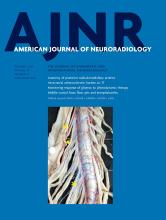Research ArticleNeurointervention
Open Access
Outcome Study of the Pipeline Embolization Device with Shield Technology in Unruptured Aneurysms (PEDSU)
D. Atasoy, N. Kandasamy, J. Hart, J. Lynch, S.-H. Yang, D. Walsh, C. Tolias and T.C. Booth
American Journal of Neuroradiology December 2019, 40 (12) 2094-2101; DOI: https://doi.org/10.3174/ajnr.A6314
D. Atasoy
aFrom Karadeniz Technical University (D.A.), Farabi Hospital, Trabzon, Turkey
N. Kandasamy
bDepartments of Neuroradiology (N.K., J.H., J.L., T.C.B.)
J. Hart
bDepartments of Neuroradiology (N.K., J.H., J.L., T.C.B.)
J. Lynch
bDepartments of Neuroradiology (N.K., J.H., J.L., T.C.B.)
S.-H. Yang
dDepartment of Radiology (S.-H.Y.), Wan Fang Hospital, Taipei Medical University, Taipei, Taiwan
eDepartment of Radiology (S.-H.Y.), School of Medicine, College of Medicine, Taipei Medical University, Taipei, Taiwan
D. Walsh
cNeurosurgery (D.W., C.T.), King’s College Hospital National Health Service Foundation Trust, London, UK
C. Tolias
cNeurosurgery (D.W., C.T.), King’s College Hospital National Health Service Foundation Trust, London, UK
T.C. Booth
bDepartments of Neuroradiology (N.K., J.H., J.L., T.C.B.)
fSchool of Biomedical Engineering and Imaging Sciences (T.C.B.), King’s College London, London, UK.

References
- 1.↵
- Nelson PK,
- Lylyk P,
- Szikora I, et al
- 2.↵Premarket approval. https://www.accessdata.fda.gov/scripts/cdrh/cfdocs/cfpma/pma.cfm?ID=P100018. Accessed June 12, 2019
- 3.↵
- Kallmes DF,
- Hanel R,
- Lopes D, et al
- 4.↵
- 5.↵
- Becske T,
- Kallmes DF,
- Saatci I, et al
- 6.↵
- Pereira VM,
- Kelly M,
- Vega P, et al
- 7.↵
- Colby GP,
- Lin LM,
- Caplan JM, et al
- 8.↵
- 9.↵
- 10.↵
- Comin J,
- Kallmes DF.
- 11.↵
- Brinjikji W,
- Lanzino G,
- Cloft HJ, et al
- 12.↵
- 13.↵
- Brasiliense LBC,
- Stanley MA,
- Grewal SS, et al
- 14.
- Shapiro M,
- Becske T,
- Riina HA, et al
- 15.↵
- Duckworth EAM,
- Nickele C,
- Hoit D, et al
- 16.↵
- Martínez-Galdámez M,
- Lamin SM,
- Lagios KG, et al
- 17.↵
- Lylyk P,
- Miranda C,
- Ceratto R, et al
- 18.↵
- Szikora I,
- Berentei Z,
- Kulcsar Z, et al
- 19.↵
- Fischer S,
- Vajda Z,
- Perez MA, et al
- 20.↵
- Martínez-Galdámez M,
- Lamin SM,
- Lagios KG, et al
- 21.↵
- 22.↵
- 23.↵
- Matsuda Y,
- Chung J,
- Lopes DK.
- 24.↵
- Hagen MW,
- Girdhar G,
- Wainwright J, et al
- 25.↵
- Arrese I,
- Sarabia R,
- Pintado R, et al
- 26.↵
- Brinjikji W,
- Murad MH,
- Lanzino G, et al
- 27.↵
- 28.↵
- Saatci I,
- Yavuz K,
- Ozer C, et al
- 29.↵
- 30.↵
- Ahmed SU,
- Mocco J,
- Zhang X, et al
- 31.↵
- 32.↵
- 33.↵
- Wang Y,
- Truong TN,
- Yen C, et al
- 34.↵
- 35.↵
- Lettau M,
- Sauer A,
- Heiland S, et al
- 36.↵
- Boddu SR,
- Tong FC,
- Dehkharghani S, et al
- 37.↵
- 38.↵
- Shapiro M.
- 39.↵
- Attali J,
- Benaissa A,
- Soize S, et al
- 40.↵National Institute for Health and Care Excellence. Medical technologies guidance [MTG10], 2012. https://www.nice.org.uk/guidance/mtg10/chapter/4-NHS-considerations. Accessed May 14, 2017
- 41.↵
- 42.↵
- Iosif C,
- Camilleri Y,
- Saleme S, et al
In this issue
American Journal of Neuroradiology
Vol. 40, Issue 12
1 Dec 2019
Advertisement
D. Atasoy, N. Kandasamy, J. Hart, J. Lynch, S.-H. Yang, D. Walsh, C. Tolias, T.C. Booth
Outcome Study of the Pipeline Embolization Device with Shield Technology in Unruptured Aneurysms (PEDSU)
American Journal of Neuroradiology Dec 2019, 40 (12) 2094-2101; DOI: 10.3174/ajnr.A6314
0 Responses
Jump to section
Related Articles
- No related articles found.
Cited By...
- Outcome study of the Pipeline Vantage Embolization Device (second version) in unruptured (and ruptured) aneurysms (PEDVU(R) study)
- Multicenter Experience with the Pipeline Flex and Vantage with Shield Technology for Intracranial Aneurysm Treatment
- Excessive platelet inhibition following Pipeline embolization of intracranial aneurysms
- Postprocedural Thrombosis following Endovascular Treatment of Intracranial Aneurysm with Flow Diverters or Coiling: A Histologic Study
- The utility of platelet inhibition testing in patients undergoing Pipeline embolization of intracranial aneurysms
- Outcome of Flow Diverters with Surface Modifications in Treatment of Cerebral Aneurysms: Systematic Review and Meta-analysis
- Periprocedural to 1-year safety and efficacy outcomes with the Pipeline Embolization Device with Shield technology for intracranial aneurysms: a prospective, post-market, multi-center study
- Advances in endovascular aneurysm management: flow modulation techniques with braided mesh devices
This article has not yet been cited by articles in journals that are participating in Crossref Cited-by Linking.
More in this TOC Section
Similar Articles
Advertisement











